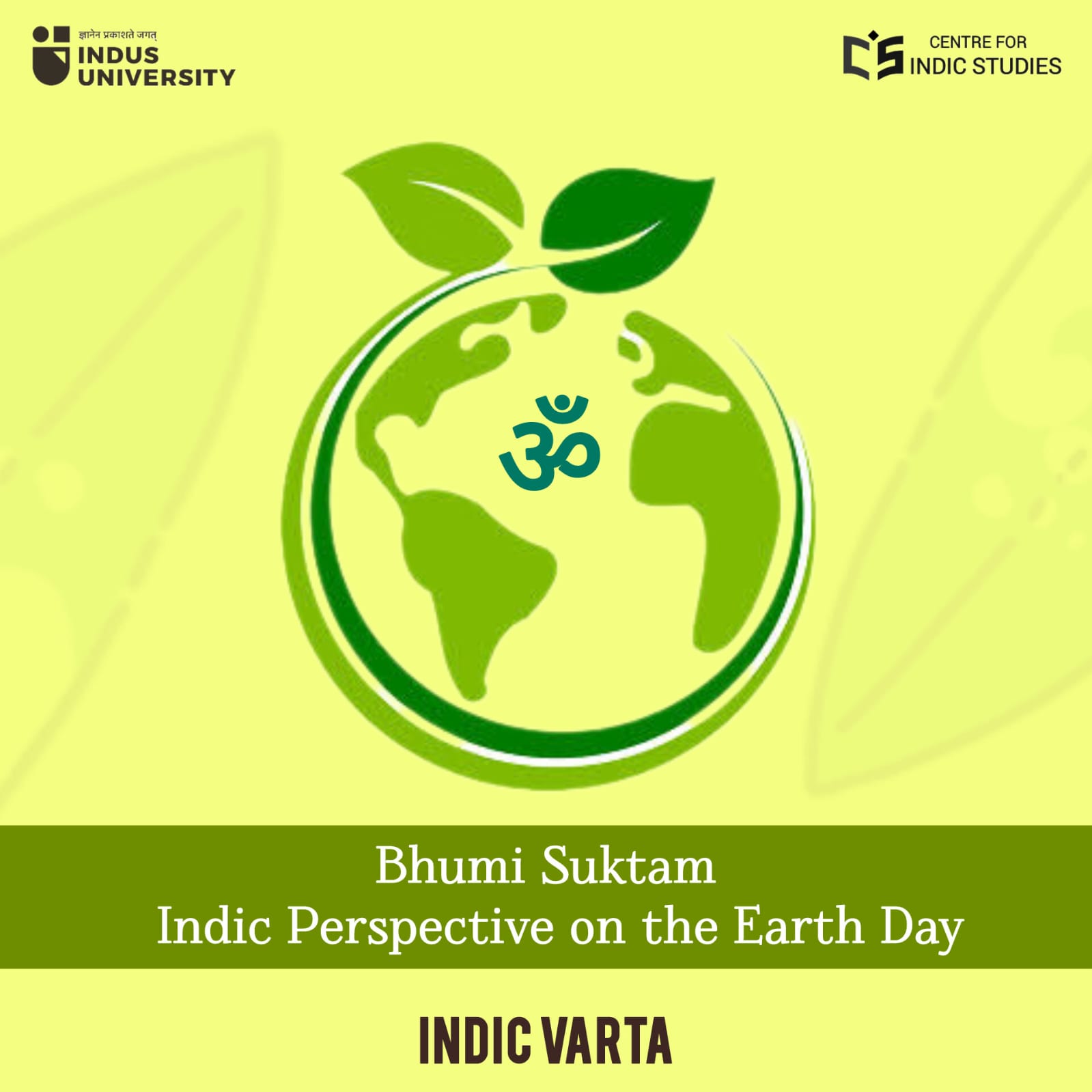- Visitor:146
- Published on: 2025-04-22 03:31 pm
Bhumi Suktam: Indic Perspective on the Earth Day
Earth is sacred and regarded as the Mother of all living beings, known as Bhudevi (भूदेवी). She is also referred to as Prithvi, Vasundhara, or Vasudha (पृथ्वी, वसुधरा, वसुधा). Hindus honor the Earth as a symbol of tolerance, forbearance, patience, and steadfastness. Mother Earth is respected for her natural resources, including forests, herbs, minerals, and vegetation. The Bhumi Suktam illustrates that the Earth is not just a piece of land; she embodies the essence of creator and sustainer, requiring nurturing with devotion.

Earth Day, celebrated annually on April 22, serves as a global reminder of our collective responsibility toward environmental protection. Originating in the 1960s, this important day continues to engage communities across the nation. However, an in-depth look at the effectiveness of commemorating Earth Day reveals that dedicating a single day or even a week or month to environmental activities is insufficient to address the urgent issues plaguing our planet. To genuinely promote sustainability and tackle pressing environmental concerns, eco-friendly practices must become ingrained in our daily routines. An Indic perspective offers a meaningful solution by encouraging sustainable practices as not just duties but as everyday life choices. This article investigates how contemporary environmental challenges can be addressed through insights drawn from traditional customs and the Indic ethos.
Historical Overview of Earth Day
The impact of pollution became increasingly evident in the 1960s, prompting a call for action. Following a devastating oil spill in 1969, a movement emerged to raise awareness about the escalating environmental crises. The first Earth Day took place on April 22, 1970, focusing on educating participants about the importance of conservation. Each year, Earth Day adopts a new theme that shines a light on urgent issues like climate change, plastic pollution, and sustainable development. While this annual event has inspired significant reforms, it often falls short of addressing the underlying structural and philosophical roots of our ecological challenges, insights that have long been emphasized by Indic traditions.
Bhumi Suktam as the Motherly Embodiment of Earth
Ancient Indian views on environmental sustainability find their foundation in Vedic and traditional philosophies, which prioritize a balanced relationship with nature. These teachings advocate for a holistic understanding of the cosmos and caution against materialism, promoting measured consumption. By revisiting these age-old principles, we can uncover solutions to today’s environmental issues and advance sustainable development. The ‘Bhumi Suktam’ from the Atharvaveda is a vital ancient text that highlights the intrinsic connection between humans and their environment. Within its 63 verses, this hymn beautifully portrays Mother Earth as the very essence of our existence and a symbol of the entire ecosystem. It reveres the Earth as a nurturing force, fostering environmental awareness and sustainability. This relationship accentuates the critical role of cultural practices in nurturing an ecocentric worldview.
These verses, dating back nearly 5000 years, provide a fascinating glimpse into a worldview that emphasizes living in harmony with nature. During that time, people experienced relatively few environmental challenges, yet their writings reflect a deep sensitivity towards the natural world. This perspective reveals a profound understanding of interconnectivity recognizing that human well-being is intricately linked to the health of the environment.
What’s remarkable is that these ancient societies cultivated a sense of environmental sustainability long before modern industrialization introduced widespread ecological challenges. They appreciated the delicate balance of ecosystems and often developed practices that honored this balance, promoting stewardship of the land and resources.
Furthermore, their emphasis on harmony with nature can inspire contemporary discussions about sustainability. As we face pressing issues like climate change, pollution, and biodiversity loss, revisiting these ancient insights can remind us of the wisdom that has existed throughout history. It serves as a call to respect and protect our environment, encouraging practices that prioritize the health of our planet for future generations. By integrating these age-old philosophies into our modern lives, we can foster a more sustainable approach to living and reconnect with the natural world in meaningful ways.
The ‘Prithvi Sukta’ contains essential principles of life, environmental sustainability, peaceful coexistence and resultant multicultural approaches. Many of the verses are very relevant to the present times of strife, conflict and mindless exploitation of the environment. The very first mantra goes like:
सत्यं बृहदृतमुग्रं दीक्षा तपो ब्रह्म यज्ञः पृथिवी धारयन्ति ।
सा नो भूतस्य भव्यस्य पत्न्युरुं लोकं पृथिवी नः क्रणोतु ॥ (AV 12.1.1)
[Infallible devotion to truth, correct knowledge, courage, active life, performance of one’s duty, superior knowledge and liberality (or sacrifice)- these all sustain the Earth. That very Earth, the protector of what will be, may grant us wide space (for our sustenance.]
The mantra emphasizes the fundamental nature of Earth as both a sustainer and protector. It suggests that Earth can sustain all life only when individuals prioritize superior knowledge over self-interest and selfish motives. This knowledge is characterized by devotion to truth, courage, penance, and efficiency in actions (कर्मसुकौशलम). Protecting the Earth cannot be achieved when personal interests take precedence over nurturing the environment. Rather than stopping exploitation with mere slogans, true change occurs when society cultivates empathy from a place of inner consciousness.
Earth is sacred and regarded as the Mother of all living beings, known as Bhudevi (भूदेवी). She is also referred to as Prithvi, Vasundhara, or Vasudha (पृथ्वी, वसुधरा, वसुधा). Hindus honor the Earth as a symbol of tolerance, forbearance, patience, and steadfastness. Mother Earth is respected for her natural resources, including forests, herbs, minerals, and vegetation. The Bhumi Suktam illustrates that the Earth is not just a piece of land; she embodies the essence of creator and sustainer, requiring nurturing with devotion:
ये ग्रामा यदरण्यं याः सभा अधि भूम्या॑म् ।
ये सँग्रामाः सर्मितय॒स्तेषु चारुं वदेम ते ॥ (AV 12.1.53)
[Whatever villages (abodes of men), whatever forests, whatever assemblies, whatever hostilities and gatherings are held on you, in them may we speak what is pleasant (चारु) to you]
In ancient Indian texts, Bhumi Devi is revered as a sacred and pious entity, embodying the Earth’s profound significance. The associated hymn emphasizes the importance of honoring, remembering, and dedicating efforts to her during various events, gatherings, and assemblies. This Indic perspective highlights the practice of paying homage to the Earth before embarking on any undertaking, reflecting a deep-seated cultural respect for the environment. Contrastingly, the Western viewpoint often prioritizes education, advocacy, and activism focused on environmental protection, framing the Earth primarily as a resource to be safeguarded from exploitation. However, the Indic approach is distinct in its action-oriented philosophy, which underscores an intrinsic connection to the Earth as a living being rather than merely a source of utilitarian value. This holistic reverence for Bhumi Devi presents a paradigm that encourages sustainable interaction with the planet, promoting a view that transcends the notion of Earth as a commodity to be preserved solely for human benefit:
ग्रिय॑स्ते पर्वता हिमवन्तोऽर॑ण्यं ते पृथिवि स्योनम॑स्तु । बभ्रु कृष्णां रोहिणीं विश्वरूपां ध्रुवां भूर्मि पृथिवीमिन्द्र॑गुप्ताम् । अजीतोऽर्हतो अक्षतोऽध्य॑ष्ठां पृथिवीम॒हम् ॥ (AV 12.1.11)
[O Earth! Let your hills and mountains full of snow as well as the forest be for your pleasure. I shall command the earth which bears all the (बभ्रुम), fit for tilling, ever-growing, that has many forms stable and extensive and protected by Indra. I shall be unconquered, uninjured and infallible.]
The hymn shows that terms such as ‘Indraguptām’ delve deeper than just the idea of physical protection; they evoke a sense of divine guardianship and highlight the sacred balance of nature. In contrast to the modern worldview, which often places humanity at the center as conquerors or caretakers of the environment, the ‘Bhumi Sukta’ offers a more humble perspective. It presents human beings as cohabitants of the Earth, who thrive on its generosity and express gratitude for its gifts. This ancient hymn provides a rich, spiritually infused vision of ecology that moves beyond the fragmented and often superficial approaches of contemporary sustainability practices. It calls for a profound shift not only in our behaviors towards the Earth but also in the very way we perceive our relationship with it. Instead of viewing nature as something to be exploited, we are invited to embrace an attitude of reverence, fostering a sense of coexistence rather than control. Ultimately, this text encourages us to rethink how we engage with the world around us, highlighting the importance of harmony and mutual respect in nurturing our planet:
यस्यामार्पः परिचराः संमानीर॑होरात्रे अर्प्रमादं क्षर॑न्ति ।
सा नो भूमिभूरिधारा पयौदुहामथौ उक्षतु वर्चसा ॥ (AV 12.1.9)
[On whom the circulating waters with similar qualities flow day and night, without failure let that earth of many streams give us milk (and other enjoyable things); thereafter let her sprinkle us with splendour.]
The deeper meaning within the Vedic verse presents a profound and holistic understanding of the relationship between humanity and the Earth. It illustrates a vision of a symbiotic connection, emphasizing the necessity of living in harmony with nature. This perspective encourages us to appreciate the myriad gifts our environment provides, such as clean air, fresh water, and fertile land while also embracing our role as responsible stewards. In contrast to the often reactive approaches seen in initiatives like Earth Day, which tend to focus on addressing problems after they arise, the Vedic outlook promotes a proactive and almost devotional attitude toward the natural world.
It serves as a reminder that our well-being is intricately linked to the health and vitality of the planet. By caring for the Earth, we nurture not only our immediate surroundings but also ourselves and future generations. This shift in mindset fosters a deeper sense of connection and responsibility that extends beyond mere conservation efforts. It urges us to cultivate a genuine appreciation for the interdependence of all life. By adopting an attitude of respect and reverence for nature, we can find fulfillment not only in what we take from the Earth but also in what we contribute back, ultimately creating a sustainable future where both humanity and nature can thrive together.
Eco-friendly: The Duality of the Term
Regarding the term "eco-friendly," it carries an unconscious duality that separates humans from the ecosystem, implying that we are external to nature and must act "in favor" of it. This perspective subtly reinforces the notion that environmentalism is a choice or an additional responsibility, rather than an innate way of being. At a glance, “eco-friendly” refers to products, actions, or systems that are not harmful to the environment, suggesting less carbon, less plastic, and reduced harm. However, this definition stems from a transactional worldview, treating the Earth as a resource to be managed more effectively rather than honored more deeply. Over the decades, Earth Day has become increasingly symbolic, often highlighted by events promoting green consumerism, such as reusable bags, solar panels, and eco-labeled goods. While these initiatives are essential, the core focus remains on managing nature rather than revering it. The Earth is still treated as an asset to be preserved for future use, not as a sacred reality.
In Bharatiya thought, the Earth is not considered a neutral "ecosystem" to be friendly with. She is the Mata—our Prithvi Devi, our sustainer, and the witness of all karma. The ‘Bhumi Suktam’ of the Atharvaveda does not speak of "managing" the Earth; instead, it emphasizes coexisting with her rhythms, respecting her patience, and fulfilling our duty toward her.
Environmental Sensitivity as a Way of Life
The practices for sustainability and the protection of the Earth, revered as Mother in the Indic perspective, are deeply embedded within the daily rituals and habits of Hindu families. Revering Mother Earth does not require special occasions or slogans; it is fundamentally woven into the Indic worldview. This is evident in the worship of rivers like the Ganga and Yamuna, the sun during Chhath Puja, and various traditions such as Govardhan Puja and Nag Panchami. Indic ideology emphasizes living in harmony with the environment and biosphere. Here are a few case studies that illustrate these practices:
(a) Bhoomi Puja is a customary ceremony conducted before the construction of a new building or home. This ritual seeks blessings from the Earth and divine entities to ensure the prosperous completion of the project and the well-being of future residents. The ceremony includes reciting prayers, presenting offerings, and seeking consent from the Earth to disturb its surface for construction purposes.
(b) Practices such as feeding stray animals, performing Gau Seva, and offering leftover food to dogs or ants are viewed not merely as acts of charity but as ecological responsibilities that reflect a lifestyle choice.
(c) In Southern India, women create traditional household drawings known as 'Kolam' in their front yards during the early morning hours. These ritual drawings are performed by individuals from various states in India, each known by different names such as Rangoli, Mugu, and Alpana. Approximately twenty million Tamil women create these innovative drawings using rice flour on the thresholds of their homes every day. A few hours after the Kolam is drawn, it typically shows small holes where creatures have eaten the flour, symbolizing a connection to the natural world.
The Way Forward, Rekindling Sacred Ecology
We find ourselves facing a profound environmental crisis, one that goes beyond just technological or scientific challenges. It’s deeply rooted in our civilization’s philosophies and values. The term “eco-friendly” has become so commonplace that it often obscures a more significant issue—the extractive mindset that treats nature merely as a resource to be managed or protected, rather than as an integral part of our existence.
In contrast, the Indic worldview provides a refreshing perspective that emphasizes relationship and connection. It invites us to see the Earth not merely as a resource, but as a nurturing mother—a sacred being worthy of respect and care. This means embracing daily practices that honor the natural world, such as feeding animals, nurturing plants, or expressing gratitude to rivers and soil, transforming these acts into meaningful rituals of regeneration.
Sustainable living, as illustrated by Indic traditions, emerges not from imposing regulations but from cultivating a deep sense of reverence for the Earth. The notion that the Earth needs saving overlooks a crucial truth: it is we who must remember our place within her sacred embrace. Acts like feeding cows, dogs, crows, and caring for the land are not just nostalgic gestures; they represent a forward-looking ethic of coexistence.
As we stand at a critical juncture between ecological collapse and planetary healing, it’s essential to shift our focus from just celebrating Earth Day to embracing Earth Dharma. By returning to ancient texts like the Bhūmi Sūktam and practicing daily acts of care and feeding, we can begin bridging the gap between our thoughts on ecology and our actions. The transformation we seek will not come solely from policies but will arise from a profound cultural and spiritual reorientation. It’s time to awaken our collective consciousness and foster a genuine connection with the environment.
- 73 min read
- 7
- 0










